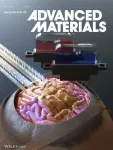(Press-News.org) Artifical intelligence not only affords impressive performance, but also creates significant demand for energy. The more demanding the tasks for which it is trained, the more energy it consumes. Víctor López-Pastor and Florian Marquardt, two scientists at the Max Planck Institute for the Science of Light in Erlangen, Germany, present a method by which artificial intelligence could be trained much more efficiently. Their approach relies on physical processes instead of the digital artificial neural networks currently used.
The amount of energy required to train GPT-3, which makes ChatGPT an eloquent and apparently well-informed Chatbot, has not been revealed by Open AI, the company behind that artificial intelligence (AI). According to the German statistics company Statista, this would require 1000 megawatt hours – about as much as 200 German households with three or more people consume annually. While this energy expenditure has allowed GPT-3 to learn whether the word 'deep' is more likely to be followed by the word 'sea' or 'learning' in its data sets, by all accounts it has not understood the underlying meaning of such phrases.
Neural networks on neuromorphic computers
In order to reduce the energy consumption of computers, and particularly AI-applications, in the past few years several research institutions have been investigating an entirely new concept of how computers could process data in the future. The concept is known as neuromorphic computing. Although this sounds similar to artificial neural networks, it in fact has little to do with them as artificial neural networks run on conventional digital computers. This means that the software, or more precisely the algorithm, is modelled on the brain's way of working, but digital computers serve as the hardware. They perform the calculation steps of the neuronal network in sequence, one after the other, differentiating between processor and memory.
"The data transfer between these two components alone devours large quantities of energy when a neural network trains hundreds of billions of parameters, i.e. synapses, with up to one terabyte of data" says Florian Marquardt, director of the Max Planck Institute for the Science of Light and professor at the University of Erlangen. The human brain is entirely different and would probably never have been evolutionarily competitive, had it worked with an energy efficiency similar to that of computers with silicon transistors. It would most likely have failed due to overheating.
The brain is characterized by undertaking the numerous steps of a thought process in parallel and not sequentially. The nerve cells, or more precisely the synapses, are both processor and memory combined. Various systems around the world are being treated as possible candidates for the neuromorphic counterparts to our nerve cells, including photonic circuits utilizing light instead of electrons to perform calculations. Their components serve simultaneously as switches and memory cells.
A self-learning physical machine optimizes its synapses independently
Together with Víctor López-Pastor, a doctoral student at the Max Planck Institute for the Science of Light, Florian Marquardt has now devised an efficient training method for neuromorphic computers. "We have developed the concept of a self-learning physical machine," explains Florian Marquardt. "The core idea is to carry out the training in the form of a physical process, in which the parameters of the machine are optimized by the process itself."
When training conventional artificial neural networks, external feedback is necessary to adjust the strengths of the many billions of synaptic connections. "Not requiring this feedback makes the training much more efficient," says Florian Marquardt. Implementing and training an artificial intelligence on a self-learning physical machine would not only save energy, but also computing time. "Our method works regardless of which physical process takes place in the self-learning machine, and we do not even need to know the exact process," explains Florian Marquardt. "However, the process must fulfil a few conditions." Most importantly it must be reversible, meaning it must be able to run forwards or backwards with a minimum of energy loss.“ "In addition, the physical process must be non-linear, meaning sufficiently complex" says Florian Marquardt. Only non-linear processes can accomplish the complicated transformations between input data and results. A pinball rolling over a plate without colliding with another is a linear action. However, if it is disturbed by another, the situation becomes non-linear.
Practical test in an optical neuromorphic computer
Examples of reversible, non-linear processes can be found in optics. Indeed, Víctor López-Pastor and Florian Marquardt are already collaborating with an experimental team developing an optical neuromorphic computer. This machine processes information in the form of superimposed light waves, whereby suitable components regulate the type and strength of the interaction. The researchers‘ aim is to put the concept of the self-learning physical machine into practice. "We hope to be able to present the first self-learning physical machine in three years," says Florian Marquardt. By then, there should be neural networks which think with many more synapses and are trained with significantly larger amounts of data than today's.
As a consequence there will likely be an even greater desire to implement neural networks outside conventional digital computers and to replace them with efficiently trained neuromorphic computers. "We are therefore confident that self-learning physical machines have a strong chance of being used in the further development of artificial intelligence," says the physicist.
END
Efficient training for artificial intelligence
New physics-based self-learning machines could replace the current artificial neural networks and save energy
2023-09-22
ELSE PRESS RELEASES FROM THIS DATE:
Re-wetting is key for boosting CO2 storage in southern peatlands
2023-09-22
DURHAM, N.C. – Maintaining a water level between 20 and 30 centimeters below the local water table will boost southern peatlands’ carbon storage and reduce the amount of climate-warming carbon dioxide (CO2) and methane they release back into the atmosphere during dry periods by up to 90%, a new Duke University study finds.
“We could immediately reduce U.S. carbon losses by 2% to 3% of our total national goal by applying this guideline on about 100,000 acres of restored or partially restored peatlands currently found across ...
New study unveils direct synthesis of FCMs via solid-state mechanochemical reaction between graphite and PTFE
2023-09-22
A research team, led by Professor Jong-Beom Baek and his team in the School of Energy and Chemical Engineering at UNIST have achieved a significant breakthrough in battery technology. They have developed an innovative method that enables the safe synthesis of fluorinated carbon materials (FCMs) using polytetrafluoroethylene (PTFE) and graphite.
Fluorinated carbon materials have garnered considerable attention due to their exceptional stability, attributed to the strong C-F bonding—the strongest among carbon single bonds. However, traditional methods of fluorination involve highly toxic reagents such as hydrofluoric acid (HF), making them unsuitable for practical ...
Gold nanoclusters can improve electrochemical water splitting to produce hydrogen
2023-09-22
As energy demand continues to rise, research into new, efficient renewable and clean energy sources is an urgent priority. Currently, renewable energy sources like solar, wind, tide, and geothermal make up less than 40% of the current energy demand. Increasing this percentage and reducing the amount of fossil fuels used will require other, more efficient renewable and clean energy sources.
Hydrogen is a promising alternative, but it is currently produced using steam reforming, which is inefficient and produces CO2 emissions. Electrochemical water splitting, also called ...
Study finds connection between gut microbiome and bone density
2023-09-22
BOSTON – There is growing evidence that a relative abundance of certain gut microbes may be related to skeletal health, according to a new study published in Frontiers in Endocrinology. If confirmed by additional research, the findings could provide the opportunity to alter gut microbiomes to achieve better bone health, as scientists learn more about “osteomicrobiology,” a new term recently used to characterize this relationship.
Due to the lack of large-scale human studies of the gut microbiome and skeletal health, researchers led by Paul C. Okoro, Data Scientist II at Hebrew SeniorLife and Hinda and Arthur Marcus Institute for ...
A dendritic cell vaccine was safe and induced immune responses in patients with multiple myeloma
2023-09-22
Bottom Line: A dendritic cell vaccine administered before and after autologous stem cell transplant (ASCT) was safe and immunogenic and was associated with durable clinical responses in patients with high-risk multiple myeloma.
Journal in Which the Study was Published: Clinical Cancer Research, a journal of the American Association for Cancer Research (AACR)
Authors: Frederick L. Locke, MD, chair of the Blood and Marrow Transplant and Cellular Immunotherapy Department at Moffitt Cancer Center, was the senior author of the study.
Background: “Multiple ...
One-stop implementation from signal detection to processing
2023-09-22
In order to explore brain disorders and discover potential treatments, it is crucial to analyze and interpret the signals transmitted by the brain. Although neural probes attached to the brain can effectively detect subtle bio- signals, they lack the ability to amplify and process these signals, necessitating the use of a separate amplifier. The research team identified a solution in common household “inkjet printers” that have been widely available for a long time.
A collaborative research team led by Professor Sungjune Jung (Department of Materials Science and Engineering, Department of Convergence IT Engineering) with PhD candidate ...
New target to beat cancer drug resistance
2023-09-22
University of Queensland researchers have identified a novel drug target with the potential to overcome drug resistance and prevent tumour regrowth in cancer patients.
Associate Professor Helmut Schaider from UQ’s Frazer Institute said the newly identified molecule was not currently a target for treatment, opening the potential for drug development.
“Drug resistance is the single major cause of death in cancer patients,” Dr Schaider said.
“For example, almost half of patients with lung cancer die ...
Australian research leads to clinical trial for rare women’s cancers
2023-09-22
An international clinical trial exploring a new way to treat rare and aggressive gynaecological cancers has launched in Melbourne.
Based on a WEHI-led discovery, the trial hopes to enhance treatment options for women with two of the most lethal gynaecological cancers – ovarian and uterine carcinosarcomas.
The study will offer a novel combination therapy for women with these relapsing cancers and is now open in Australia, with plans to expand to Canada and the United Kingdom in coming months.
At a glance
New clinical trial launches in Melbourne to test a potential treatment for two aggressive and rare gynaecological ...
Newer diabetes treatments are understudied in Black populations and may be less beneficial
2023-09-22
New research analysing the effects of two drugs used to treat type 2 diabetes indicates a consistent lack of cardiovascular and renal benefits in Black populations. Cardiovascular disease is the leading cause of severe illness and death associated with type 2 diabetes. Renal disease is also a common complication of type 2 diabetes.
The drugs, called sodium-glucose co-transporter 2 inhibitors (SGLT2-Is) and glucogen-like peptide 1 receptor agonists (GLP1-RAs), are some of the newer treatments prescribed to lower blood sugar levels in people with type 2 diabetes.
The research findings, published in the Journal of the ...
Ochsner offers tuition assistance to aspiring nurses and doctors
2023-09-22
NEW ORLEANS, LOUISIANA – Ochsner Health is again expanding its Ochsner Scholars program for aspiring nurses and physicians ready to fill critical healthcare shortages in local communities and shape the healthcare workforce of the future.
Ochsner is excited to announce tuition assistance for 100 Nurse Scholars pursuing Associate Degree in Nursing (ADN), Licensed Nurse Practitioner (LPN), Bachelor of Science in Nursing (BSN) and Accelerated Bachelor of Science in Nursing (ABSN) degrees this spring to students across Louisiana and Mississippi. Ochsner is also covering tuition for up to 10 Physician Scholars ...
LAST 30 PRESS RELEASES:
Space computing power networks: a new frontier for satellite technologies
Experiments advance potential of protein that makes hydrogen sulfide as a therapeutic target for Alzheimer’s disease
Examining private equity’s role in fertility care
Current Molecular Pharmacology achieves a landmark: real-time CiteScore advances to 7.2
Skeletal muscle epigenetic clocks developed using postmortem tissue from an Asian population
Estimating unemployment rates with social media data
Climate policies can backfire by eroding “green” values, study finds
Too much screen time too soon? A*STAR study links infant screen exposure to brain changes and teen anxiety
Global psychiatry mourns Professor Dan Stein, visionary who transformed mental health science across Africa and beyond
KIST develops eco-friendly palladium recovery technology to safeguard resource security
Statins significantly reduce mortality risk for adults with diabetes, regardless of cardiovascular risk
Brain immune cells may drive more damage in females than males with Alzheimer’s
Evidence-based recommendations empower clinicians to manage epilepsy in pregnancy
Fungus turns bark beetles’ defenses against them
There are new antivirals being tested for herpesviruses. Scientists now know how they work
CDI scientist, colleagues author review of global burden of fungus Candida auris
How does stroke influence speech comprehension?
B cells transiently unlock their plasticity, risking lymphoma development
Advanced AI dodel predicts spoken language outcomes in deaf children after cochlear implants
Multimodal imaging-based cerebral blood flow prediction model development in simulated microgravity
Accelerated streaming subgraph matching framework is faster, more robust, and scalable
Gestational diabetes rose every year in the US since 2016
OHSU researchers find breast cancer drug boosts leukemia treatment
Fear and medical misinformation regarding risk of progression or recurrence among patients with breast cancer
Glucagonlike peptide-1 receptor agonists and asthma risk in adolescents with obesity
Reviving dormant immunity: Millimeter waves reprogram the immunosuppressive microenvironment to potentiate immunotherapy without obvious side effects
Safety decision-making for autonomous vehicles integrating passenger physiological states by fNIRS
Fires could emit more air pollution than previously estimated
A new way to map how cells choose their fate
Numbers in our sights affect how we perceive space
[Press-News.org] Efficient training for artificial intelligenceNew physics-based self-learning machines could replace the current artificial neural networks and save energy





